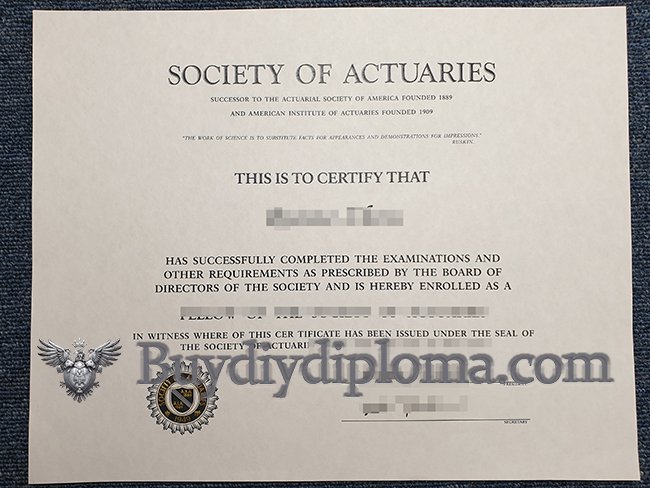
The Society of Actuaries (SOA) in the United States is an internationally representative and authoritative organization with a large number of member actuaries. It was founded in 1889. Currently, there are about 30,000 members, and SOA has about 830 members in China. Mainland China members are mainly concentrated in Beijing, Shanghai, and Shenzhen. SOA is a global actuarial education and research institution that has developed into a professional association of actuaries in the world, providing excellent actuaries worldwide and awarding qualifications. Since an actuary is a very professional profession, it is generally necessary to pass a qualification test to determine the qualifications for employment. Canadian Actuarie Fake Certificate The internationally renowned actuarial societies include the Actuarial Society of North America, the Actuarial Society of the United Kingdom, the Actuarial Society of Japan and the Actuarial Society of Australia. Different actuaries associations have different qualifications and examination courses and systems. Among them, the most representative and authoritative international organization with the largest number of member actuaries is the Society of Actuaries (SOA) in the United States, which enjoys a high reputation. how to buy a fake SOA certificate, buy FSA certificate online, buy SOA fake diploma, buy a Fellow of Society of Actuaries certificate, buy Society of Actuaries fake certificate, There are approximately 16,500 regular and associate members. As an international actuarial education and research institution, American Actuaries Fake Certificate. SOA’s main task is to provide actuarial education programs in the areas of life insurance, health insurance, employee benefits, and pensions, and to improve the consultation and resolution of actuaries in the form of follow-up education involving uncertain events. Ability to finance, insurance, finance, and social issues.
Quasi-actuary stage
Course 1: Mathematical Foundations of Actuarial Science
Description: The purpose of this course is to develop knowledge about some basic mathematical tools and to develop the ability to assess risks from a quantitative perspective, especially to apply these tools to solve problems in actuarial science. And suppose that the students have mastered the basics of calculus, probability theory and risk management before learning this course.
Main contents and concepts: calculus; probability theory; risk management (including loss frequency; loss amount; retention amount; deductible; joint insurance and risk premium).
Lesson 2: Interest Theory, Economics, and Finance
Description: This course includes interest theory, intermediate microeconomics and macroeconomics, and the foundation of finance. Basic knowledge of calculus and probability theory is required before studying this course.
Main contents and concepts: interest theory; microeconomics; macroeconomics; financial basis.
Lesson 3: Actuarial Models on Risk (Actuarial Models)
Description: Through the study of this course, students will develop the basic knowledge of the actuarial model of random events and the application of these models in insurance and financial risks. Before you study this course, you need to be proficient in calculus, probability theory, buy SOA fake certificate, buy FSA fake certificate, how to be the Fellow of Society of Actuaries? and mathematical statistics. Participants are advised to study this course after passing Course 1 and 2.
Main content and concepts: insurance and other financial random events; survival models; population data analysis; quantitative analysis of the financial impact of random events.
Lesson 4: Actuarial Modeling
Description: This course provides an initial introduction to the basics of building models and important actuarial and statistical methods for modeling. Before learning this course, you should be familiar with the relevant content of calculus, linear algebra, probability theory, and mathematical statistics.
Main content and concepts: definition of the model; why and how to use the model; model advantages and disadvantages; deterministic and random models; model selection; input and output analysis; sensitivity test; experience and feedback of research results; regression analysis; Forecast; risk theory; reliability theory.

 All Samples
All Samples US Diplomas
US Diplomas CAD Diplomas
CAD Diplomas UK Diplomas
UK Diplomas AUS Diplomas
AUS Diplomas MAY Diplomas
MAY Diplomas GER Diplomas
GER Diplomas Other Diplomas
Other Diplomas